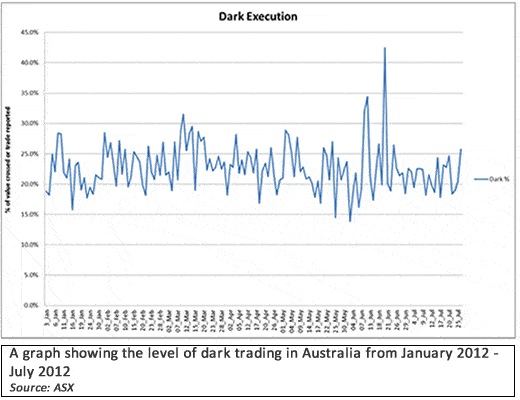The Australian Securities Exchange (ASX) has urged regulators to rein in dark trading, after revealing the practice accounted for around 25% of all Australian equity market executions in the first six months of 2012.
As part of its submission to a consultation by regulator the Australian Securities and Investment Commission (ASIC), the ASX stated that the growing share of non-displayed trading was damaging price formation in lit markets.
“There is clear evidence, both in Australia and overseas, that an increase in dark execution results in widening spreads, higher costs for investors and a negative impact on price discovery,” read the ASX response.
Australian dark trading platforms include broker crossing networks, non-displayed venues such as Liquidnet, and the ASX’s own CentrePoint mid-point crossing facility, which accounted for around 3% of dark trading according to the exchange’s own data. The bourse also pointed out that dark trading reached a peak of 43% of overall executions during one week in the middle of June (see chart).

The ASX backed ASIC’s proposal that dark pools must provide meaningful price improvement of at least one tick or a mid-point cross for orders below block size. Block size would be defined as orders over A$200,000, A$500,000 or A$1 million, depending on the market capitalisation of the stock in question.
The exchange also favoured a minimum threshold of A$50,000 for dark orders, starting with a A$25,000 limit to be imposed as soon as possible.
“It is important to be mindful that while price improvement may benefit the individual investor, the removal of liquidity from the lit market will negatively impact market quality on which all investors rely,” added the ASX submission. “It is appropriate that breach of [the price improvement] rule attracts the maximum penalty of A$1 million…and ASIC must resist attempts to water-down implementation of the rule.”
ASX also urged ASIC to level the playing field between broker crossing engines and regulated trading venues.
“The growth in dark execution means that a growing proportion of trades are occurring on venues which do not have the same regulatory standards as licensed markets,” read the response. “These venues are effectively private exchanges as they involve the systematic matching of orders and should be regulated in the same way as public lit markets that perform the same function.”
The ASIC consultation, known as CP179, suggested draft guidance on market operators’ systems and controls, amendments to rules governing extreme price movements and proposals to enhance data for market supervision. Many of the rule changes proposed in CP179 follow feedback from another consultation on Australian market structure called CP168.
Respondents to CP168 expressed concern over high-frequency trading and dark pools, urging ASIC to let competition between trading venues develop further before introducing further new rules.
The regulator also proposed new guidelines earlier this week on the oversight and controls for automated market systems as part of the ongoing market structure reforms.